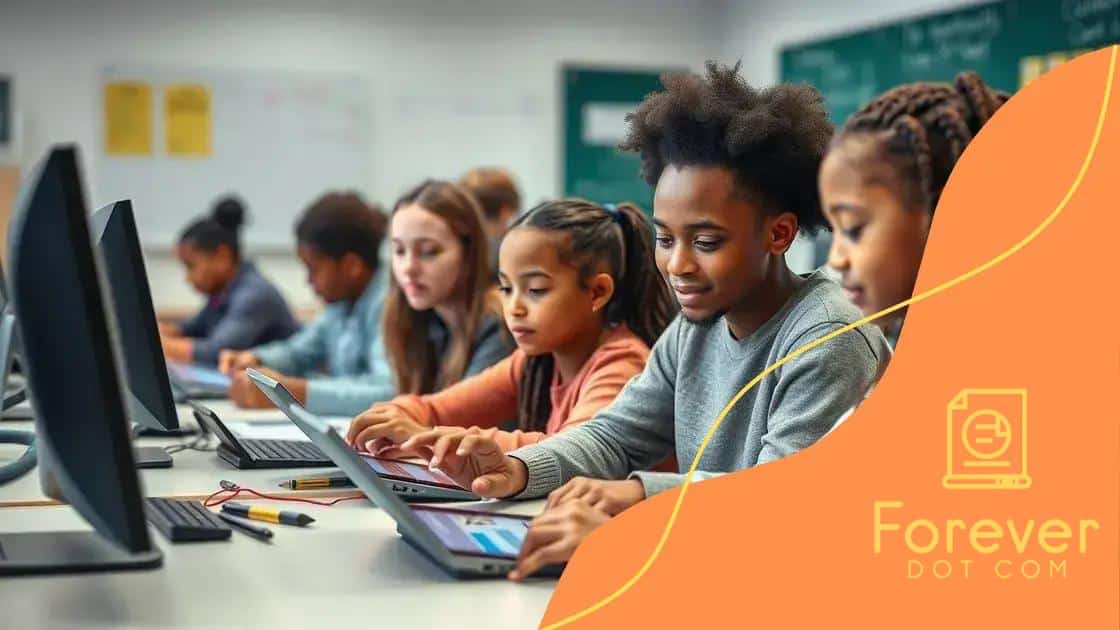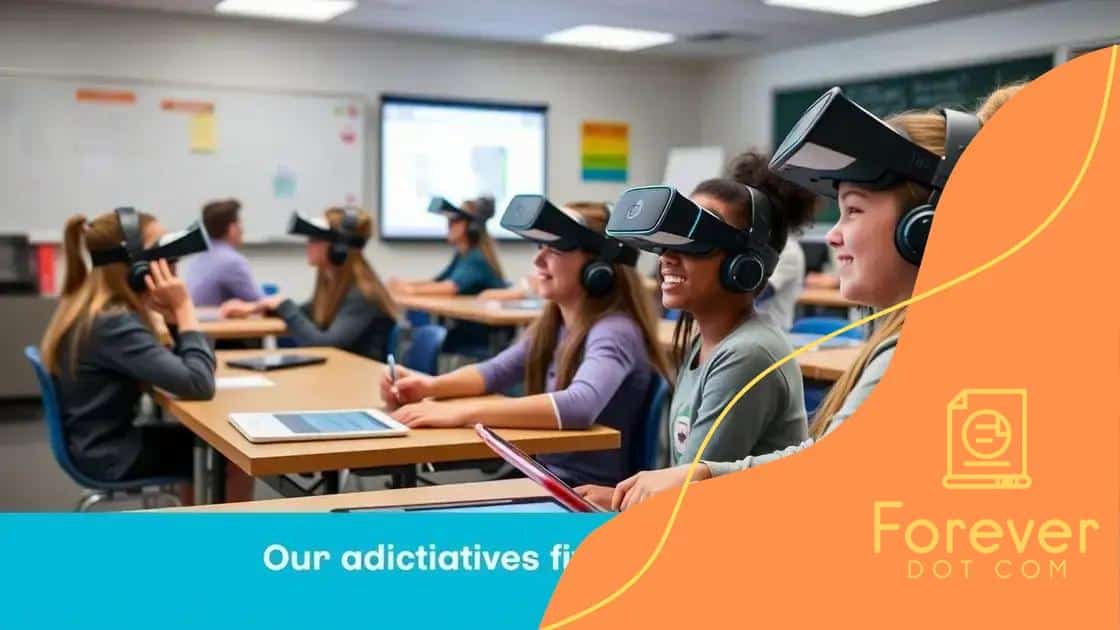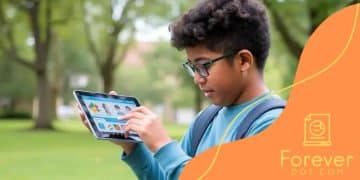Trends in adaptive learning technologies for diverse learners

Adaptive learning technologies personalize education through AI-driven solutions, enhancing engagement and learning outcomes for diverse learners while addressing challenges like data privacy and equitable access.
Trends in adaptive learning technologies for diverse learners are reshaping the educational landscape. Have you ever considered how these technologies cater to individual learning needs? Let’s explore their impact on education.
Understanding adaptive learning technologies
Understanding adaptive learning technologies is crucial for educators today. These technologies tailor educational experiences to meet the diverse needs of each learner. By utilizing data and algorithms, they adjust content according to student performance and learning preferences.
Key Features of Adaptive Learning Technologies
One of the main features is personalization. This means that each student receives a customized learning path that aligns with their strengths and weaknesses. Another significant aspect is real-time feedback, which helps students learn more effectively.
- Data-driven insights help identify gaps in understanding.
- Interactive content keeps students engaged.
- Flexible pacing allows learners to progress at their own speed.
Adaptive learning systems also employ artificial intelligence to analyze how students interact with the material. This can lead to improved outcomes because it identifies areas where a student may struggle and provides targeted resources. Additionally, these technologies can support various learning styles, catering to visual, auditory, and kinesthetic learners.
Benefits of Using Adaptive Learning
Implementing adaptive learning technologies offers numerous benefits. First, these tools can increase student motivation through engaging materials that feel relevant. Second, they promote mastery by ensuring that students thoroughly understand concepts before moving on.
- Enhances retention of knowledge.
- Encourages self-directed learning.
- Facilitates collaborative learning opportunities.
As institutions adapt to new learning environments, understanding these technologies becomes increasingly important. Teachers can leverage these tools to create a more personalized and effective classroom experience, allowing every student a better chance at success.
Benefits for diverse learners
Adaptive learning technologies provide several benefits for diverse learners. By personalizing the education experience, these tools help each student achieve their full potential, regardless of their learning style or background.
Enhanced Engagement
One major advantage is the increase in student engagement. When learners interact with content that suits their needs, they are more motivated to participate. This can lead to a richer learning experience filled with exploration and curiosity.
- Interactive elements capture attention.
- Gamification makes learning fun.
- Tailored content keeps students interested.
Moreover, adaptive learning technologies allow students to progress at their own pace. This flexibility is vital for those who may need more time to grasp concepts or those who can advance quickly. Students feel more in control of their learning journey, which can boost confidence.
Meeting Varied Learning Styles
Different learners absorb information in various ways. Some are visual learners, while others may prefer auditory or kinesthetic methods. Adaptive learning solutions often cater to these different styles by providing a range of resources, such as videos, podcasts, and interactive activities.
- Catering to visual learners with graphs and images.
- Supporting auditory learners through narrated content.
- Engaging kinesthetic learners with hands-on activities.
Additionally, these technologies can help teachers identify individual strengths and weaknesses. With data-driven insights, educators can offer targeted support where it is needed most, ensuring that no student falls behind.
This individualized approach also enhances collaboration among learners. By understanding different perspectives and working together, diverse learners can support one another, fostering a sense of community. In this way, adaptive learning technologies not only support academic success but also build essential social skills.
Recent innovations in the field

Recent innovations in the field of adaptive learning technologies are transforming how education is delivered. These advancements are making learning more personalized and accessible for all students. Technologies such as artificial intelligence (AI) and machine learning play an essential role in these innovations.
AI-Driven Personalization
One major innovation is the use of AI to provide personalized learning experiences. AI algorithms analyze a student’s performance data to suggest tailored resources and study plans. This ensures that learners receive the support they need when they need it.
- Adaptive quizzes that adjust difficulty based on responses.
- Customized learning paths to meet individual needs.
- Instant feedback that helps students improve.
Another exciting development is the integration of virtual and augmented reality (VR/AR) into learning environments. These technologies create immersive experiences that can enhance understanding and retention of complex subjects. Students can explore environments that would be impossible to access in real life.
Mobile Learning Solutions
The rise of mobile learning is shaping the landscape of education. Adaptive learning apps allow students to learn on-the-go, making education more flexible. This accessibility is especially beneficial for diverse learners who may not have traditional resources available.
- Learning App Functionality:
- Gamified learning experiences keep students engaged.
- Offline capabilities enable learning without internet access.
Moreover, cloud-based technologies enable educators to share resources easily and track student progress in real-time. This collaboration enhances the learning experience as teachers can modify their approach based on insights from the data.
Additionally, advancements in analytics tools are providing deeper insights into student behavior and engagement. This data helps educators identify effective teaching strategies, ensuring that diverse learner needs are being met. As these innovations continue to unfold, the future of education looks promising, with technologies enhancing personalized learning and fostering student success.
Challenges in implementing adaptive solutions
While adaptive learning technologies present numerous benefits, they also face several challenges in implementing adaptive solutions. Understanding these obstacles is essential for educators and administrators as they navigate the changing landscape of education.
Resource and Training Needs
One significant challenge is the need for adequate resources and training. Schools often lack the necessary funding for the latest technologies, which can hinder effective implementation. Moreover, teachers must be trained to use these tools effectively.
- Professional development programs are crucial for skill-building.
- Budget constraints can limit technology purchases.
- Continuous support is necessary to ensure effective usage.
As a result, without proper training, educators may struggle to integrate adaptive technologies in their classrooms, potentially leading to underutilization.
Data Privacy and Security Concerns
Another challenge involves data privacy and security. Adaptive learning technologies rely on collecting significant amounts of student data to personalize learning experiences. However, this raises concerns about how that data is managed and protected.
- Regulations like FERPA impact data management practices.
- Protecting student privacy is essential for trust.
- Schools must implement strong cybersecurity measures.
Concerns about data breaches can make schools hesitant to adopt new technologies, potentially limiting their benefits to students.
Furthermore, ensuring equitable access to these technologies can be a struggle. Some students may not have access to necessary devices or reliable internet at home, creating disparities in learning opportunities. This digital divide can affect the effectiveness of adaptive learning solutions.
In addition, cultural and curriculum adaptation needs pose another challenge. Educational content must resonate with diverse learners, reflecting their backgrounds and experiences. Without relevant content, adaptive learning technologies might not engage students effectively.
Future outlook on adaptive learning technologies
The future outlook on adaptive learning technologies appears promising, driven by rapid advancements in technology and an increasing focus on personalized education. As educators and learners become more attuned to these tools, their potential will continue to expand.
Integration of Advanced Technologies
One significant area of growth is the integration of artificial intelligence and machine learning into adaptive learning platforms. These technologies will allow for even greater levels of personalization. For instance, systems may evolve to predict student needs based on their learning patterns, making real-time adjustments to lesson plans.
- Improved analytics will help educators understand student progress better.
- AI can facilitate intelligent tutoring systems that adapt to individual learning styles.
- Seamless integration with existing educational tools will enhance usability.
Moreover, the incorporation of virtual reality (VR) and augmented reality (AR) into adaptive learning will create immersive learning experiences. Students may engage in simulations that bring complex concepts to life, allowing them to practice skills in a safe environment.
Greater Accessibility and Inclusivity
Accessibility is also a crucial focus for the future of adaptive learning technologies. As technology becomes more affordable, schools across various socioeconomic backgrounds can adopt these tools. This will help bridge the gap between students who have access to resources and those who do not.
- Cloud-based solutions will allow flexible learning anywhere.
- Mobile learning applications will support education outside traditional environments.
- Mother tongue support will enhance engagement for diverse learners.
Additionally, adaptive technologies will likely focus on inclusivity, ensuring that resources are designed for all learning styles and abilities. This means creating content that resonates with a global audience, reflecting multiple cultures and languages.
The role of data privacy will also play a critical part in shaping the future. As schools navigate compliance with regulations, there will be a strong emphasis on protecting student data while using these technologies. Transparent practices will be essential in building trust among parents and educators.
In conclusion, adaptive learning technologies are set to revolutionize education by providing personalized and inclusive experiences for diverse learners. As we embrace innovations like AI and VR, we will see improved engagement and better learning outcomes. However, we must also address challenges like resource needs, data privacy, and equitable access to truly benefit all students. By focusing on these areas, we can create an educational landscape that is not only effective but also fair for everyone.
FAQ – Frequently Asked Questions about Adaptive Learning Technologies
What are the main benefits of adaptive learning technologies?
Adaptive learning technologies provide personalized learning experiences, which enhance engagement and improve the understanding of diverse learners.
How do AI and VR contribute to adaptive learning?
AI allows for real-time adjustments based on student performance, while VR offers immersive experiences that make complex subjects easier to understand.
What challenges do schools face when implementing these technologies?
Schools often encounter issues like budget constraints, the need for teacher training, and concerns about data privacy.
Why is inclusivity important in adaptive learning?
Inclusivity ensures that adaptive learning technologies meet the needs of all students, reflecting diverse backgrounds and learning styles.






